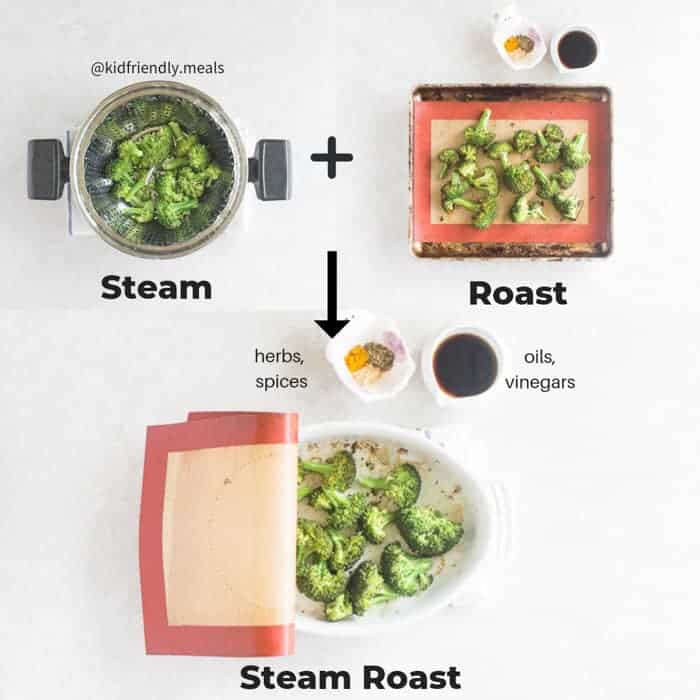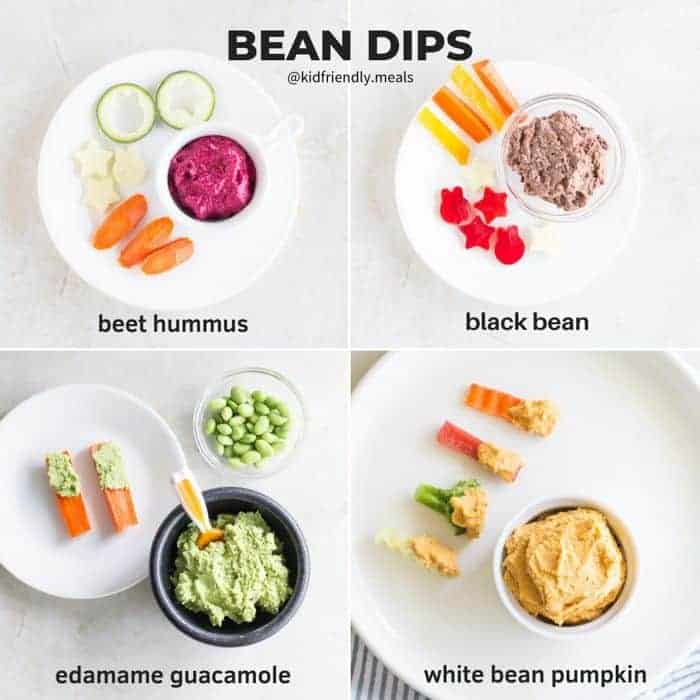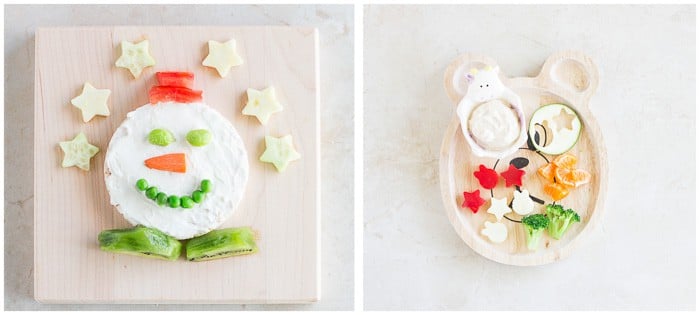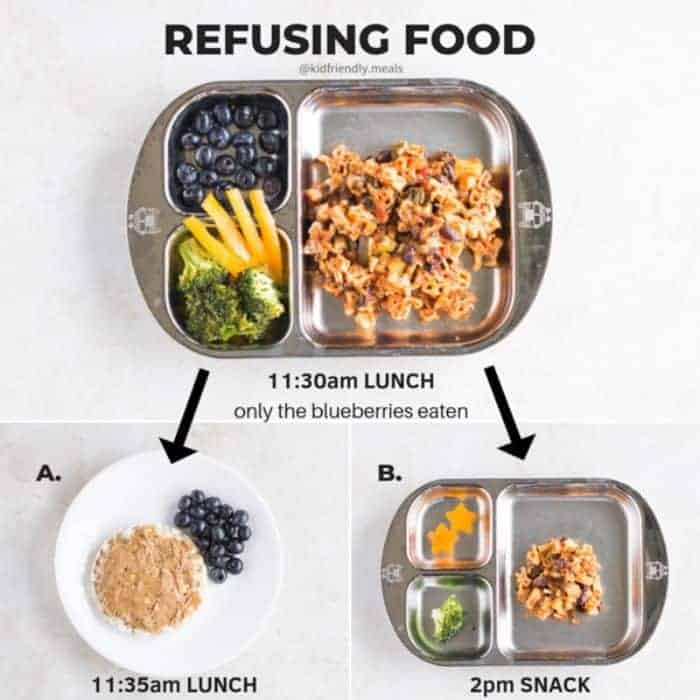Start early!
Babies are born with innate food preferences for sweet and salty foods over bitter and sour. But that doesn’t mean veggies don’t have a chance! We know from research that the more we, as parents, expose our children to a wide variety of veggies the more likely she will learn to appreciate and love them! I highly recommend you give this a read! And the earlier they make a regular appearance on your child’s plate, the better. That’s because babies are more likely to try new foods compared to older children as food neophobia, fear of new foods, peaks at around 2-6 years of age. They also begin to test their boundaries (dear Lord, save us) and become more selective about what they will and will not eat. I always say, take full advantage of that window of opportunity! Early introduction is critical in helping to shape your child’s food preferences, which has been shown to track throughout childhood and beyond (2). I set a goal for myself to introduce 100 new foods before 1. If you’d like to see the food list, check out our Baby Led Weaning – First 3 months.
Oops, we totally missed that window. What now?
EXPOSURE, EXPOSURE, EXPOSURE (x infinity). Whether or not your child decides to eat them is their decision. Our job, as parents, is to provide plenty of opportunities for them to come face-to-face with their veggies. They might get completely ignored, patted (yes!), licked (yes yes!), tossed (“darn, I could’ve eaten that!”), but that’s still exposure. And every.single.one counts. You never know when that magical, hallelujah moment will happen so don’t give up! It might be after serving 50 times that your child decides the vegetable in question is not so scary anymore and musters the courage to give it a try. Keep offering! Constant exposure leads to familiarity which leads to acceptance. What counts as exposure? Read this post! So at this point, you’re probably thinking, “Keep offering. Got it! But how?!” Here are some practical strategies you should try!
Switch up cooking methods
I did a whole post on this so definitely check it out – how to cook vegetables for babies and toddlers.
Less is More
I personally don’t do seafood with an exoskeleton (thanks to my dad who spoiled me all my life by doing the dirty work for me and handing me just the good stuff). So if someone hands me a whole platter of lobster, my natural instinct is to push it away. So next time you find yourself filling up your child’s plate with mounds of veggies, picture your “lobster.” You’re winning for getting the veggie on the plate, even if it’s just one piece. As your child starts to open up to _____ (veggie), you can certainly start serving more.
Serve vegetables with familiar foods
like dips! Recipes for these can be found on my Instagram page – @kidfriendly.meals Having too many new/unfamiliar foods can be quite intimidating for a child. Make sure there’s something on the plate that your child is familiar with and likes. Sure, your child may only eat the familiar food. But just seeing the vegetable counts as exposure. The more your child sees it, the more it will become familiar. Also, this strategy can give you a peace of mind knowing that at least something on the plate will get eaten. Which leads me to my next tip. Also add to foods that kids generally love, like pizza and French toast!
Presentation matters!
After all, we eat with our eyes first, right? Make veggies fun by cutting into fun shapes (I’ve been getting SUCH good use out of these cookie cutters!) like stars, bears, bunnies…You can also make the plate fun by adding colorful foods. Oh another thing. Y’all. Let me tell you! Utensils have magical powers! Whenever mine says no to certain foods, I simply hand him a utensil and the rest is history!
Try not to become a short order cook
It’s super tempting to quickly whip up your child’s favorite food if the meal you served gets no love (option A in image above). We, mamas, just want to see our babies fed and happy! But ask yourself, “will I be able to do this every time?” If the answer is no, then you have to put your foot down. Otherwise, you’re just encouraging their behavior as they start to make the association of “ooh, if I refuse to eat this, mommy will give me something else that I love!”
Stick to a mealtime schedule
Avoid offering snacks all day out of fear that your child will starve. That will inevitably lead to decreased appetite during mealtimes. Remember, it’s OK for your child to feel hungry. In fact, hunger is key in motivating children to try new foods. Think about what you do when you’re hungry. I don’t know about you, but I shove anything and everything in sight. Here’s what you can do. Try to schedule meals at least 2 hours apart. That way, even if your child didn’t eat much during the previous meal, they will know that there will be another chance to eat soon (option B in the image above). Check out this post to see our past and current schedules.
Keep the pressure and expectation low
In my 30s, I’m still finding that if someone pushes me to do something that I don’t have full conviction about, it will make me want to do it even less! Something tells me you can relate. So how can we expect our little ones to eat their veggies when pressured to do so? It will actually have quite the opposite effect. Instead, let’s take a deep breathe and fall back on the division of responsibility. You got the food on the table. Their job is to decide what, how much, and whether or not they’d eat. I also like to remind myself that family mealtimes aren’t just about the food itself. It’s about creating memories together. So the less you put your focus on what’s being eaten and more on enjoying each other’s company, mealtimes will become that much more joyous rather than a battleground. You just might notice that more food gets gobbled up by your little one too!
LEAD by example
Our pastor recently preached a sermon series on parenting, and one of the things he kept reiterating was that our children will learn MOST from our actions, not our words. That stuck with me. Simply enjoying the veggies, or any food for that matter, with your child can work miracles! Our children truly do learn best by observing what we do, and I always get a good laugh whenever my son decides that the food he just rejected a second ago is worth his time once he sees me eat it. Then there are times when even though we are eating the exact same thing, what’s on my plate is much more appealing to him. So then we end up sharing a plate which is fun too (but not so much when I am starving). Hope you give these simple strategies a try starting today! Keep the eating environment safe and positive and keep serving those vegetables. Play the long game! And remember. You’re NOT failing as a mom if your child isn’t eating their vegetables. You are doing awesome! Need SIMPLE and REALISTIC tips and strategies for adding variety into your child’s diet? Join my FREE 5-day email series!





